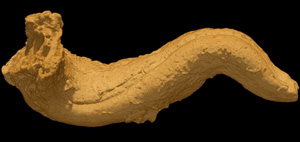Current Research
The split between the research of staff and that of research fellows is not always justified as much research is a joint effort.
Research and Projects are funded currently by a variety of sources including: The National Science Foundation, The Seashore Endowment of the Texas Natural Science Center, and The Jackson School of Geosciences
Staff

Exterior three-dimensional model created from data collected by CT scanning the same specimen (NPL4387 Caprinuloidea perfecta)
Research projects currently focus on the extinct hippuritid bivalve, the ‘rudist‘.
We are examining internal structures using computed tomography (CT) on specimens with suitable preservation.
External patterns of encrustation and boring are of equal importance as they indicate relationships with other organisms within the reef-mound setting.
Perhaps most exciting is the possibility that the growth patterns of some of the more massive rudists, such as the radiolitids Durania and Sauvegesia may provide rhythms which could link to climatic or tidal characteristics of the environment in which they existed.
Research Fellows

Chris Garvie with his 2006 Strimple Award from The Paleontological Society. This is the highest honor for an avocational paleontologist to achieve. Chris has published several important papers addressing Tertiary molluscan fauna.
Roger and Dee Ann Cooper: Lamar University
(Big Bend stratigraphy)
Chris Garvie:
(Cretaceous and Tertiary molluscs especially gastropods)
Brenda Kirkland: Mississippi State University
(Permian reef forms, and algae)
Hannes Loesser: UNAM, Mexico
(Cretaceous corals)
Linda McCall:
(Cretaceous molluscs)
Keith Minor:
(Cretaceous ammonites)
Charles Newsom: University of Iowa (retired)
(Cretaceous oysters)
Chris Schneider: University of Alberta
(Paleozoic biodiversity)
Robert (Bob) Scott: University of Tulsa
(Cretaceous stratigraphy and paleontology)
James Sprinkle: University of Texas at Austin (Retired)
(Early Paleozoic echinoderms)
Louis Zachos: University of Mississippi, Oxford
(Tertiary echinoids)
Sally Zellers: University of Central Missouri
(Neogene foraminifera)
Emeritus Research Fellows
William (Bil)l Ward (deceased): (Cretaceous stratigraphy)



